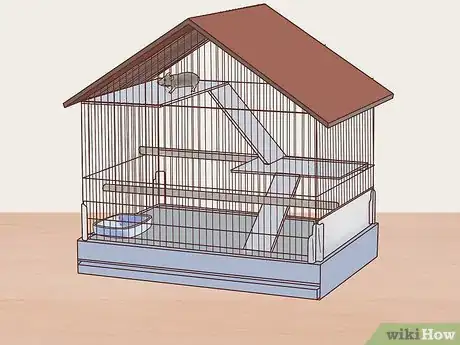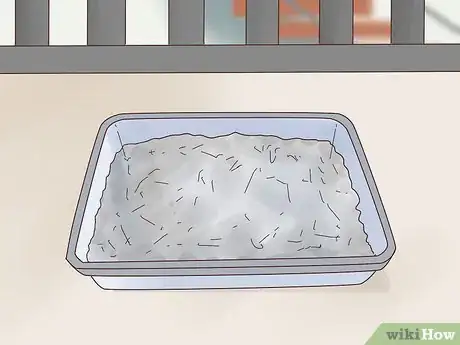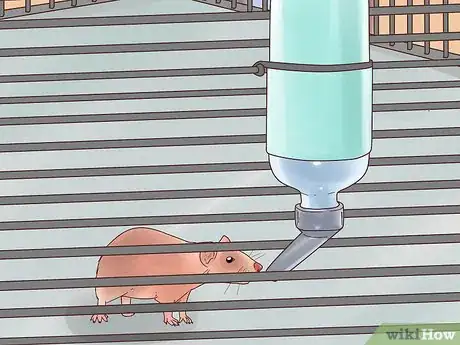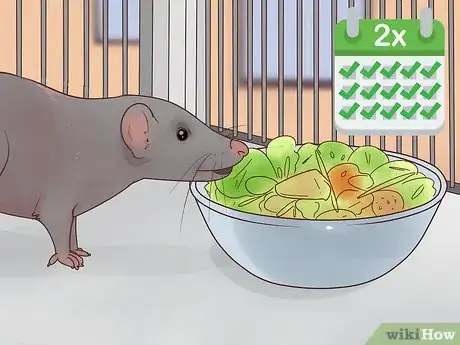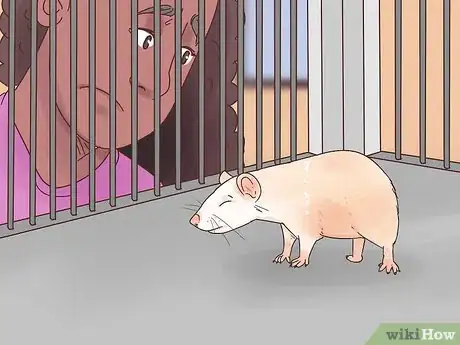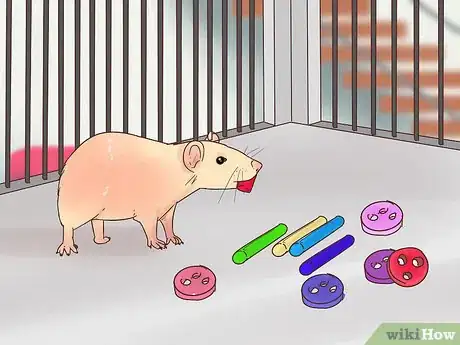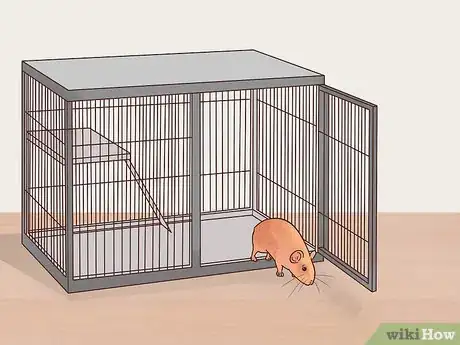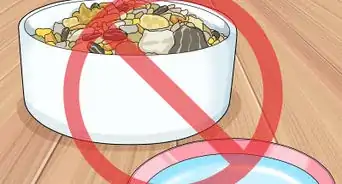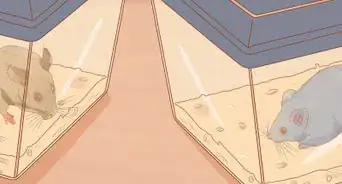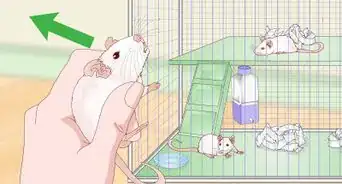This article was co-authored by Pippa Elliott, MRCVS. Dr. Elliott, BVMS, MRCVS is a veterinarian with over 30 years of experience in veterinary surgery and companion animal practice. She graduated from the University of Glasgow in 1987 with a degree in veterinary medicine and surgery. She has worked at the same animal clinic in her hometown for over 20 years.
There are 11 references cited in this article, which can be found at the bottom of the page.
This article has been viewed 7,769 times.
Manx rats, also known as tailless rats, are some of the cutest rats around. Usually born without tails, they’re shorter and rounder than most other rats, and are generally much smaller. However, these rats are also prone to experiencing more health problems in their life than other types of domestic rats. By providing your rat with a good cage, diet, and exercise regimen, and by paying special attention to its health, you can provide your Manx rat with a loving home and comfortable lifestyle.
Steps
Housing and Feeding Your Rat
-
1Make your rat’s cage as large and interesting as possible. Rats are intelligent and playful creatures, and will become bored or even depressed living in a cramped cage with no stimulation. Fill your cage with fun toys for your rat to play with.[1]
- The minimum recommended size for a rat cage is 24 inches (61 cm) in length, 24 inches (61 cm) in width, and 14 inches (36 cm) in height.[2]
- Wire cages are ideal for rats, as they allow rats to climb up the walls and provide good ventilation. Use a solid tray for the floor rather than wire.[3]
- Make sure the top of the cage is secure; rats are very intelligent and are good at escaping from enclosures.
-
2Add paper-based litter to the floor of the cage. Proper bedding is very important to a rat’s health. Use paper-based litter to absorb ammonia from rat droppings. Avoid using bedding made out of softwood or clumping cat litter.[4]
- You might also consider using shredded paper, paper towels, or non-clumping corncob litter for bedding.
- Aspen shavings are the safest option if you want to use a wood-based litter.
- Clean droppings out of the cage roughly once a week.
Advertisement -
3Keep your rat cage in a cool location out of the sun. Manx rats are particularly prone to overheating due to their lack of a tail. Place their cage somewhere cool that won’t get hotter than 90 °F (32 °C).[5]
- Rats use their tails to release heat from their bodies, which makes tailless varieties like the Manx rat more likely to suffer from heat stress. Regulate their temperature closely.
- Keep your cage out of unheated rooms like garages or areas with a draught. Although Manx rats are most prone to overheating, they can also become very uncomfortable in chilly locations.[6]
-
4Place a nest box in the cage for your rat to sleep in. In addition to needing a place to sleep, your rat will simply want some privacy every once in a while. Use a small cardboard box with shredded paper bedding for an ideal sleeping spot.[7]
- Change the nesting material whenever you change the bedding, or at least once a week.[8]
- Your nest box should be at least twice the size of your rat. You’ll want it to be cozy but not too cramped.
- Pet stores also sell pre-fashioned nest boxes. Consider purchasing one of these, or model your own after their dimensions.[9]
- In addition to a nest box, rats will also appreciate places to hide in their cage other than their nest box. Consider placing other small enclosures in the cage to give your rat some extra privacy.[10]
-
5Hang a water bottle in the cage to make water constantly available. A typical rodent sipper bottle placed on the side of the cage will be suitable.[11]
- Follow the instructions to hang the water bottle on the side of the cage, making sure that the drinking tube is accessible from inside the cage.[12]
- Keep an extra water bottle on hand, in case your rat chews through the plastic of the first bottle.
- Refill their water daily and clean the water bottle once a week.[13]
-
6Put a food bowl in the cage and feed your rat twice daily. Feed your rat a regular diet of commercially available rat food mix, while giving it small treats throughout the day.[14]
- The average adult rat should eat between 0.53 ounces (15 g) and 0.73 ounces (21 g) of food per day
- You can buy suitable rat food at any pet store.
- Supplement your rat’s normal diet with healthy snacks like fresh fruits and vegetables, yogurt, cheese, and animal protein like chicken. Rats are omnivorous, and healthy snacks for humans are usually also healthy snacks for a rat in smaller quantities.
- Avoid giving your rat sticky foods like peanut butter, as they might cause them to choke.[15]
-
7Clean the cage once a week to keep your rat in good health. Rat droppings will pile up quickly inside your rat’s cage and will give off harmful amounts of ammonia in just a few days. Replace dirty bedding once a week and scrub the rest of the cage with warm soapy water.[16]
- A strong odor coming from your rat’s cage means that it needs to be cleaned. If replacing the bedding and cleaning the cage once a week is not keeping odors away, you may need to clean the cage more regularly (e.g., twice a week instead of once a week).
Taking Care of Your Rat’s Health
-
1Monitor your rat’s temperature and regulate it to avoid heat stress. It bears repeating that your Manx rat’s lack of a tail makes it particularly susceptible to overheating. Keep your rat in a cool environment indoors and monitor it for signs of heat stress, such as falling unconscious.[17]
- If your rat overheats and falls unconscious, you can cool it off by immersing it up to its neck in cool water. Although rats don’t overly enjoy being in water, this is a good way to quickly counteract heat stress.
- Don’t leave your rat in a house without air conditioning during warmer months.[18]
-
2Watch for symptoms of illness or infection. Manx rats are particularly prone to disease or infection and may require veterinary attention more often than normal rats to stay in their best health.
- Many tailless rats have bowel and bladder control issues and commonly suffer urinary tract infections. The most common symptom for this type of condition is your rat leaving dribbles of urine wherever they walk.[19]
- Other common signs of illness in rats include loss of appetite and lethargy. If your rat begins to show signs of illness, take it to a vet for treatment as soon as possible.[20]
-
3Take your rat to the vet if it experiences pain while moving. Because of their particular breeding, some Manx rats develop rear leg and pelvic abnormalities. Although these are usually benign conditions, your rat should be taken to the vet if it begins to have difficulty moving.[21]
- Signs that a rat is in pain might include squinting or closed eyes, reluctance to move, a hunched posture, labored breathing, or whimpering.[22]
- If such physical abnormalities result in painful living conditions for your Manx rat, you may want to consider euthanization. Talk to your vet about your rat’s quality of life if its physical condition shows signs of deterioration.
-
4Keep chew toys in the rat’s cage to prevent damage to their teeth. Rat incisors grow continuously, and your rat will need to have something to chew on to wear their teeth down. Serious dental damage can come about if your rat chews too much on its cage.[23]
- Chew toys designed for parrots or dogs also make terrific chew toys for your rat.
- Other good chewable objects include unpainted wood, dog biscuits, cardboard, and rawhide chews.[24]
Giving Your Rat Entertainment and Affection
-
1Give your rat an hour of playtime each day outside of their cage. Rats love to explore, and they will naturally want to spend time outside of their cage. Let them explore their larger surroundings for an hour each day to prevent boredom over time.[25]
- Make the room as safe as possible before letting the rat out. Close windows and doors you don’t want it to pass through and remove chewable objects that may be hazardous to your rat, such as pieces of painted wood.
- Make sure you supervise your rat during their playtime. Not only can they easily disappear into nooks and crannies, but they may also chew through exposed electrical wires.[26]
- Rats are social animals, so consider keeping at least 2 rats so they won’t get lonely and they’ll have a playmate
-
2Add stimulating toys to your rat’s cage for an enriched experience. Rats love to play, and will greatly appreciate being able to have fun in their cage. Place tubes and puzzles in the cage to keep them entertained.[27]
- Crawling through cardboard or PVC tubes makes great entertainment for rats.
- Parrot toys, such as ropes and swings, and hammocks are also particularly fun for rats; consider placing a couple of these around the inside of the cage.[28]
- Many rats enjoy exercise wheels, which provide both entertainment and exercise. If you decide to put an exercise wheel in your rat cage, make sure it isn’t too small; if your rat has to arch its back while using it, the wheel needs to be bigger.[29]
-
3Hold your rat gently to affectionately handle it. Rats are very affectionate and will love to be held once they get to know you. Hold your rat by placing one hand gently under its torso and using the other to support its hind feet.[30]
- Do not squeeze your rat while holding it. Manx rats in particular are quite small, and you may injure them. Be very gentle when handling them.[31]
References
- ↑ http://www.humanesociety.org/animals/rats/tips/rat_housing.html?credit=web_id139896192
- ↑ http://www.exoticpetvet.com/rat-care.html
- ↑ https://www.bluecross.org.uk/pet-advice/caring-your-rat
- ↑ https://www.vetbabble.com/small-pets/rats/
- ↑ http://www.ratfanclub.org/cool.html
- ↑ http://www.humanesociety.org/animals/rats/tips/rat_housing.html?credit=web_id139896192
- ↑ https://www.bluecross.org.uk/pet-advice/caring-your-rat
- ↑ http://ratguide.com/care/environment/cage_accessories.php
- ↑ http://ratguide.com/care/environment/cage_accessories.php
- ↑ http://www.exoticpetvet.com/rat-care.html
- ↑ https://www.vetbabble.com/small-pets/rats/
- ↑ https://www.aspca.org/sites/default/files/rat_care.pdf
- ↑ http://www.exoticpetvet.com/rat-care.html
- ↑ https://www.bluecross.org.uk/pet-advice/caring-your-rat
- ↑ https://www.rspcansw.org.au/blog/animal-care-information/how-to-care-for-your-rat/
- ↑ https://www.aspca.org/sites/default/files/rat_care.pdf
- ↑ http://www.ratfanclub.org/cool.html
- ↑ http://www.ratfanclub.org/cool.html
- ↑ http://afrma.org/taillessrats.htm
- ↑ https://www.bluecross.org.uk/pet-advice/caring-your-rat
- ↑ http://www.afrma.org/taillesstrbl.htm
- ↑ http://ratguide.com/health/basics/signs_of_pain_in_rats.php
- ↑ https://www.vetbabble.com/small-pets/rats/
- ↑ https://www.aspca.org/sites/default/files/rat_care.pdf
- ↑ https://www.bluecross.org.uk/pet-advice/caring-your-rat
- ↑ https://www.aspca.org/sites/default/files/rat_care.pdf
- ↑ https://www.rspcansw.org.au/blog/animal-care-information/how-to-care-for-your-rat/
- ↑ https://www.aspca.org/sites/default/files/rat_care.pdf
- ↑ https://www.vetbabble.com/small-pets/rats/
- ↑ https://www.rspcansw.org.au/blog/animal-care-information/how-to-care-for-your-rat/
- ↑ https://www.bluecross.org.uk/pet-advice/caring-your-rat
